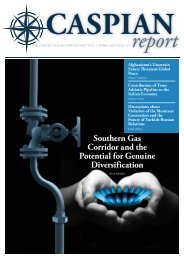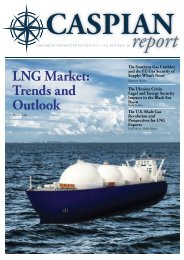Hazar Raporu - Issue 02 - Winter 2012
You also want an ePaper? Increase the reach of your titles
YUMPU automatically turns print PDFs into web optimized ePapers that Google loves.
Most of the states of Central Eurasia are<br />
landlocked, and they depend on each<br />
other’s transportation infrastructure.<br />
Building highways, railways, ports, and<br />
airports is a necessary part of Azerbaijan’s<br />
hub strategy, but it is not a sufficient<br />
one. Without a bird’s-eye approach and a<br />
coherent policy, which will view all these<br />
projects as components of a single strategy,<br />
the transportation and infrastructure<br />
projects are likely to have outcomes that<br />
will be insufficiently efficacious, because<br />
they would lack complementarity. For<br />
Central Eurasia to produce the “Dubais”<br />
and “Singapores” of the 21st century, the<br />
compartmentalized regional mindset has to<br />
give way to an integrated common vision<br />
that will direct each project towards a<br />
shared goal.<br />
Azerbaijan of 2030 or 2050 will be the<br />
product of today’s concept sketches.<br />
The core of a successful hub strategy for<br />
Azerbaijan must include Free Economic<br />
Zones (FEZ) development, on the basis<br />
that FEZs are prerequisites for generating<br />
trade and attracting Foreign Direct<br />
Investment (FDI). The current FEZ law<br />
in Azerbaijan falls short of the Production<br />
Sharing Agreement (PSA) legal framework,<br />
effectively utilized by Azerbaijan to<br />
promote its oil and gas projects. Although<br />
the non-oil sector may not be as attractive<br />
or compelling as the oil sector, given the<br />
right strategy and incentives, it could still<br />
bring in high levels of FDI, with multibillion<br />
dollar ventures across various sectors<br />
of the non-oil economy.<br />
This report recommends focusing on<br />
two projects that are directly linked to<br />
Azerbaijan’s grand hub strategy and<br />
that could generate significant FDI in<br />
the non-oil sector and raise the stakes<br />
in the country’s FEZ development.<br />
This means that the two key projects<br />
– the Port of Alyat and Baku Heydar<br />
Aliyev International Airport – should<br />
be incorporated into the FEZ concept,<br />
which in turn should be constructed on a<br />
flexible and effective legal framework (i.e.<br />
Production Sharing Agreement). This<br />
approach will produce two marketable<br />
projects that could result in a “Contract<br />
of the 21 st Century” in Azerbaijan’s<br />
non-oil sector, similar to the “Contract<br />
of the Century” signed in the energy<br />
sector in September 1994. At a regional<br />
level, Azerbaijan needs to harmonize its<br />
transport strategy with that of neighboring<br />
states, particularly Georgia, Turkey and<br />
the Central Asian countries along the<br />
East-West axis, and Russia and Iran in the<br />
North-South direction.<br />
Other Key Recommendations<br />
Strategic <strong>Issue</strong>s<br />
The Azerbaijani government<br />
needs to align all its major development<br />
projects in the non-oil sector under a<br />
single overarching objective.<br />
A coherent and integrated<br />
vision for Azerbaijan’s future hub must<br />
be developed. This strategy or a master<br />
plan should integrate and encompass all<br />
110 108










